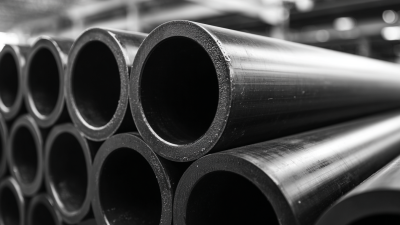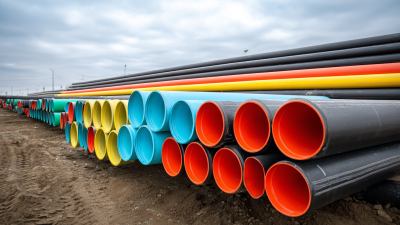-
Products and Systems
Products and Systems
Vinidex manufacturers and supplies a broad range of products & systems to suit a range of applications.
-
Solutions
Solutions
Vinidex’s products and systems are versatile and can be used in a variety of markets and applications.
- Resources
-
2025 How to Choose the Right Pressure Pipe Fittings for Your Plumbing Needs
In the ever-evolving landscape of plumbing solutions, the selection of the right pressure pipe fittings has become increasingly critical for both residential and commercial applications. As we approach 2025, industry experts project a significant rise in the demand for high-quality fittings, driven by initiatives aimed at improving water efficiency and addressing infrastructure needs. According to a recent report from Freedonia Group, the global market for pressure pipe fittings is expected to grow at a compound annual growth rate (CAGR) of 5.3% through 2025, highlighting the need for informed purchasing decisions.

Renowned plumbing industry expert, Dr. Emily Sanderson, emphasizes the importance of choosing the correct pressure pipe fittings by stating, "The longevity and efficiency of plumbing systems heavily depend on the quality and suitability of the fittings used. Proper selection can prevent leaks and minimize maintenance costs over time." With a myriad of options available, understanding the specific requirements, such as material compatibility and application suitability, will empower consumers to make choices that not only meet current plumbing demands but also adapt to future challenges.
As we delve into the nuances of pressure pipe fittings, it becomes evident that careful consideration of factors such as pressure ratings, temperature limits, and installation practices is essential for effective plumbing solutions in the upcoming years. By equipping yourself with this knowledge and leveraging expertise from industry leaders, you can ensure that your plumbing needs are met with the most efficient and sustainable solutions available.
Understanding Different Types of Pressure Pipe Fittings for Diverse Plumbing Applications
When selecting the right pressure pipe fittings for plumbing applications, it's essential to understand the various types available and their specific uses. Pressure pipe fittings are categorized based on their material, such as copper, PVC, or polypropylene, each offering unique advantages. For example, Type K, Type L, and Type M copper tubes are commonly used for plumbing and HVAC applications, with Type K being the thickest and most durable, suitable for underground or high-pressure situations, while Type L and M offer respective trade-offs in flexibility and cost.
In addition to materials, the form of the fittings—whether straight tubes, coils, or capillary tubes—also plays a significant role in their utility. Each application, whether it be water supply, HVACR, or industrial processes, has specific requirements that dictate the choice of fittings. Recent updates to specifications, particularly in polypropylene piping and the introduction of guidelines for the safe use of spray foam insulation, further enhance the selection process. By being aware of these factors, plumbers can better navigate the diverse range of pressure pipe fittings to meet their specific plumbing needs effectively.
2025 How to Choose the Right Pressure Pipe Fittings for Your Plumbing Needs
| Fitting Type | Material | Pressure Rating (psi) | Typical Applications |
|---|---|---|---|
| Elbow Fittings | PVC | 200 | Residential Plumbing |
| Tee Fittings | Copper | 300 | Water Supply |
| Coupling Fittings | Stainless Steel | 600 | Industrial Piping |
| Cap Fittings | PVC | 200 | Sealing Open Pipes |
| Reducer Fittings | Bronze | 500 | Pressure Reduction |
Key Factors to Consider When Selecting Pressure Pipe Fittings for Your Project
When selecting pressure pipe fittings for your plumbing needs, several key factors should be taken into account to ensure optimal performance and longevity. Firstly, it is crucial to understand the pressure ratings of the fittings, which are essential for maintaining system integrity under varying conditions. According to a report by the American Water Works Association (AWWA), fittings that are not rated for the intended pressure can lead to premature failures and costly leaks. Always ensure that the fittings selected exceed the maximum pressure experienced in your plumbing system, providing a safety margin for unexpected surges.
Material compatibility is another important consideration. Different materials interact uniquely with various fluids and environments. For instance, a study published in the Journal of Environmental Engineering highlights that using incompatible materials can cause deterioration, leading to system failures. The choice between materials such as PVC, CPVC, and metal fittings should be dictated by the type of fluid being transported, the temperature conditions, and the surrounding environment. This strategic selection based on environmental and fluid compatibility will significantly enhance the reliability and efficiency of your plumbing system.
Comparative Analysis of Materials Used in Pressure Pipe Fittings: Pros and Cons
When selecting pressure pipe fittings for your plumbing needs, the choice of materials is critical. Common materials used include PVC, CPVC, stainless steel, and brass, each with its own advantages and drawbacks. For instance, according to the Plastic Pipe and Fittings Association (PPFA), PVC is favored for its lightweight nature and resistance to corrosion, making it an excellent option for non-metallic applications. However, it is generally limited to lower temperature use, which may not suit all plumbing environments.
On the other hand, stainless steel fittings are heralded for their durability and ability to withstand higher pressure and temperature conditions. A report by the American Society of Mechanical Engineers (ASME) highlighted that stainless steel fittings can handle temperatures up to 1,000°F, which is essential in industrial applications. Nonetheless, the downside to stainless steel is its higher cost compared to plastic alternatives. Brass fittings strike a balance between the two, offering good strength and corrosion resistance at a moderate price point, though they can suffer from dezincification over time. Thus, careful consideration of the operational environment and fitting properties is crucial for optimal plumbing performance.

Common Mistakes to Avoid When Choosing Pressure Pipe Fittings for Plumbing Systems
When choosing pressure pipe fittings for plumbing systems, avoiding common mistakes is crucial to ensuring system efficiency and longevity. One prevalent error is selecting fittings that do not correspond to the specific pressure rating required for your application. According to a report by the American Society of Plumbing Engineers, improper pressure ratings can lead to catastrophic failures, resulting in costly repairs and water damage. Always verify that the fittings meet or exceed the pressure specifications needed for your plumbing system.
Additionally, neglecting the material compatibility between the pipe and fittings can also lead to significant issues. For instance, using PVC fittings with CPVC pipes can cause leaks and failures due to thermal expansion differences. A study published by the International Journal of Plumbing Research highlights that nearly 20% of plumbing failures stem from material incompatibility. To mitigate this risk, consider the environment in which the fittings will reside and choose materials accordingly.
**Tip:** When selecting fittings, always consult the manufacturer's guidelines and verify their compatibility with your existing plumbing system.
Another common mistake is overlooking the importance of proper installation techniques. Many plumbing systems fail due to improper fitting installation, such as over-tightening or misalignment. According to the Plumbing Equipment Manufacturers Association, improper installation increases maintenance costs by up to 30%.
**Tip:** Always engage a certified plumber to ensure the correct installation of pressure pipe fittings to enhance system reliability and performance.

Expert Tips for Ensuring Proper Installation and Maintenance of Pressure Pipe Fittings
When selecting pressure pipe fittings, proper installation and maintenance are crucial for ensuring safety and longevity. According to a report from the International Plumbing and Heating Confederation, improper installation is responsible for over 30% of plumbing failures. Therefore, it is vital to follow best practices and guidelines specific to the type of fittings and materials you are using.
**Tip 1:** Always check the compatibility of the pipes with the fittings before installation. Using the correct materials minimizes the risk of corrosion and leaks. For instance, stainless steel fittings are ideal for high-pressure applications due to their resistance to rust and degradation, as highlighted by the American Society of Mechanical Engineers.
**Tip 2:** Regular maintenance checks are essential. It is recommended to conduct inspections at least twice a year, as a report from the American Water Works Association shows that proactive maintenance can reduce leak incidents by up to 50%. Look for signs of wear, and replace any damaged fittings promptly to avoid more significant plumbing issues down the line.
Investing time in proper installation and routine maintenance ensures your pressure pipe system operates efficiently, ultimately saving costs and preventing emergencies.
Related Posts
-

Understanding the Essential Role of PE Pipe Fittings in Modern Plumbing Systems
-
Exploring the Benefits of HDPE Pipe: Why Its Durability and Chemical Resistance Make It an Industry Standard
-

Understanding the Role of Polyethylene Pipe in Sustainable Water Management Practices
-

Exploring the Versatility of Black Plastic Pipe in Modern Infrastructure Solutions
-

Understanding the Advantages of High Density Polyethylene Pipe in Modern Infrastructure Solutions
-

Understanding the Benefits and Applications of HDPE Plastic Pipe in Modern Infrastructure

